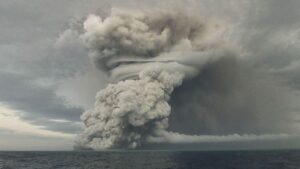The U.N. chief warns: “Climate breakdown has begun.” In this show you hear unreported climate change: “Antarctic Extreme Events” with lead author Martin Siegert, Imperial College London. Plus Dr. Martin Jucker on early start to ozone hole – and the Tongan volcano warming the world for years to come. It is breaking science from Radio Ecoshock.
Listen to or download this Radio Ecoshock show in CD Quality (57 MB) or Lo-Fi (14 MB)
Welcome. As record heat, fires and storms rock the northern Hemisphere, is there anywhere on Earth untouched by climate change? We are going where media does not, to the distant south Pole and the high stratosphere, seeking answers.
Scientists thought, we all thought the great glaciers of Antarctica were outside the climate fray, likely for thousands of years to come. Even leaders in the field are now changing their views. It turns out the seventh continent, cold home to ice miles thick, is not stable at all. Every aspect, from the deep glaciers through massive ice shelves to sea ice has been destabilized.
As you know, sea ice around Antarctica has plummeted to record low volumes not seen in our times. Even the best glaciologists don’t know why. They are convening meetings, conferences and studies trying to find out why? Is this low south polar sea ice temporary or permanent?
The area of sea ice lost is about the same size as the country of Argentina. Imagine in a desperate attempt to stall global warming, humans covered all of Argentina with mirrors to reflect the sun’s energy. By the way, massive mirror farms to help balance planetary energy is a real thing. The Meer project, spelled MEER, is working it out. In our December 2020 show, Brent Ragsdale interviewed scientist/engineer Ye Tao from Harvard about the MEER geoengineering idea, to cool the planet with reflective mirrors.
In our imaginary mirror covering Argentina, there is an unexplained breakdown. The surface on all the mirrors degrades, leaving a dark base that absorb solar energy instead. The giant mirrors fail and Earth absorbs more heat instead of cooling us. That is exactly what happened in recent years around Antarctica. Vast fields of bright white ice, acting as solar reflectors, melted away to reveal a dark ocean surface below.
Not reported in the media, and unknown to the general public, we just went through a kind of geophysical change around the South Pole that adds energy greater than a million nuclear explosions to the world’s oceans. The big loss of sea ice around Antarctic is another factor heating the world’s oceans, destabilizing weather, stoking rapid intense hurricanes or typhoons, and pushing heat waves on to land.
I’m Alex Smith. Let’s get the news straight from top scientists here on Radio Ecoshock.
==========================
PLEASE HELP RADIO ECOSHOCK KEEP GOING. We get science and activism straight to the public with weekly broadcasts to 106 non-profit radio stations in the U.S., Canada, UK, and Australia. More people from at least 80 countries downkiad the weekly free program via Soundcloud and our Ecoshock web server. It costs money to produce and distribute this program. You see no flash-up ads on this site, and nobody sends your annoying emails. All I ask is for a bit or your support, if you can. Please help with either a one-time donation or a monthly gift, on this page.
===========================
EXTREME ANTARCTICA: MARTIN SIEGERT
“A clear lesson from the geological record is one of dynamism, which reveals that the Antarctic ice sheet is not a static giant frozen in time but rather that it responds sporadically and unpredictably to large-scale environmental change; a lesson we should learn as Antarctica’s environment is changed further because of fossil-fuel burning…”
Extreme weather events are reported all over the world. Can they hit Antarctica as well? Did you know the biggest recorded heat wave, as a sudden rise in temperature, happened near the South Pole? How fragile is Antarctica, and what does that mean for the rest of us?
We have first answers in a new paper titled: “Antarctic Extreme Events”. The lead author is Dr. Martin Siegert, Visiting Professor at The Grantham Institute for Climate Change, and Imperial College London. He is a glaciologist and world-recognized Antarctic scholar.
Listen to or download this 29 minute interview with Martin Siegert in CD Quality (57 MB) or Lo-Fi (14 MB)

Even a dozen years ago, many ice experts discounted most of Antarctica from any serious change in the next thousand years. Now we have to toss out old assumptions. For example, this summer, European cities went from cold to punishing heat. Then some streets turned to instant rivers in record rain. Similar rapid changes happen in the cold house at the southern pole.
There are three domains in the ice world: ice sheets and ice shelves – which add to global sea level rise when melting, and sea ice (which does not). We could add snow plus lakes and rivers above and below the ice. This new study study also includes the biological world from microscopic to iconic species like the Emperor Penguin.
We are learning climate models are good at projecting long-term changes but still poor dealing with short-term events, like an ice-shelf breaking off, or a record heat wave over Antarctica. Maybe our future will be determined by short sharp extreme events, as much as long-term trends.
This paper is a real primer about the complex systems we over-simplify in our vision of Antarctica. Among them: deep relationships between state of Antarctic ice and the atmosphere. I recommend everyone read this paper, to grasp reality at the southern Pole, and how that will change the future for all of us. The paper is free for you to read here.
A FEW NOTES FROM THIS PAPER
1. DIRECT EFFECT OF OZONE HOLE ON ANTARCTIC CLIMATE
[The ozone hole affects…] “the climate of Antarctica, where ozone depletion has led to stratospheric cooling and resulting intensification and poleward shift of the belt of westerly winds that encircle Antarctica (Thompson and Solomon, 2002). This change in circulation patterns has led to warming over the Antarctic Peninsula and cooling in parts of East Antarctica (Thompson et al., 2011).”
FLYING BLIND!
2. WE DON’T KNOW HOW TOTAL VOLUME OF SEA ICE IS CHANGING BECAUSE WE DON’T KNOW ICE THICKNESS…
To truly understand changes in sea ice and its possible vulnerability to further change requires knowledge of sea ice volume and therefore thickness. However, estimating sea ice thickness from satellite data remains challenging, so changes in the volume of sea ice remain poorly resolved. The situation has been stressed in the World Climate Research Program (WCRP) Scientific Committee on Antarctic Research (SCAR) summary report on the International Workshop on Antarctic Sea Ice Thickness: “Sea ice thickness remains arguably the largest single gap in our knowledge of the climate system.”
3. MODELS DON’T WORK FOR ANTARCTIC SEA ICE
WORSE: Climate models consistently failed to produce sea ice levels like what actually happened. They showed a persistent decline in sea ice from 1979, even though it grew. And most models cannot predict such short term events like the 2015-2017 total crash of sea ice area around the South Pole.
4. WE CAN’T PREDICT WHETHER MORE MARINE HEAT WAVES WILL HAPPEN IN THE SOUTHERN OCEAN
Unlike the Northern Hemisphere, there have been fewer marine heat waves in the Southern Ocean, and we don’t know what the future will bring… Below the sea surface there has been a steady accumulation of heat in the Southern Ocean. This body of heat has been identified as one of the processes responsible for influencing the timing and magnitude of the rapid decrease in sea ice extent subsequent to 2017 (see above; Zhang et al., 2022).
5. WARMER SEA WATERS FROM BELOW ARE SPEEDING W. ANTARCTIC GLACIER LOSS
This Circumpolar Deep Water (CDW) is markedly warmer than water beneath ice shelves and proximal to marine-terminating glaciers. Hence, an influx of CDW has been identified as critical for melting ice shelves and glaciers in West Antarctica, including the rapidly-retreating Pine Island Glacier, Thwaites Glacier and numerous smaller glaciers along the western coast of the Antarctic Peninsula (Rignot et al., 2014; Cook et al., 2016).
6. ICE SHELVES
Ice shelves fringe three-quarters of Antarctica’s coastline, providing buttressing support that stabilises the rate of ice flow from the grounded ice sheet and its contribution to global sea level (Siegert M. J. et al., 2020)
7. MORE LAND WITHOUT ICE WILL APPEAR IN ANTARCTICA (plus dust-driven melting)
While only around 0.2%–0.4% of the Antarctic continent is exposed above the ice (Burton-Johnston et al., 2016), this proportion is likely to increase with further warming (particularly in the Antarctic Peninsula; Lee et al., 2017) and, in some places such as the Dry Valleys in East Antarctica, the area of exposure could be substantial. Such ice-free areas may act as sources of dust falling on snow and ice, reducing surface reflectivity. Thus, as extreme winds form enhanced supraglacial dust deposits, so increased melting can occur. In the Dry Valleys this can lead to sudden alteration in lake ecosystems (Doran et al., 2008). Dust-driven melting has also been observed in James Ross Island (Kavan et al., 2020) and Seymour Island (Meinander et al., 2022).
8. SEA LEVELS WERE MUCH HIGHER, AT CO2 LEVELS BELOW TODAY’S
Crucially, the Antarctic ice sheet showed significant volume change, and thus global sea-level rise of several metres, even when CO2 levels were 300–400 ppm during Pliocene “super-interglacials,” still less than present-day ~420 ppm, and much less than projected changes in the 21st century and beyond. Even larger ice sheet changes were apparent at CO2 concentrations greater than 400 ppm such as during the mid-Pliocene and Mid-Miocene (Colleoni et al., 2022).
OTHER COVERAGE of ANTARCTICA
Sky News Mon, August 7, 2023
“’Absolutely enormous heatwave’
The most extreme heatwave ever recorded globally struck East Antarctica in March 2022, sending surface temperatures soaring 38.5°C hotter than they should be.
Instead of an expected roughly -50C, they reached -10C.
Had it happened in summer, it would have begun melting the surface of the ice sheets, which scientists said they have never seen before.”
Or get this new from Youtube here.
SEE ALSO:
Study Warns Burning Fossil Fuels ‘Anywhere in the World’ Is Destructive to Antarctica
=====================================
OZONE WORRIES AND PLASMA STORMS: MARTIN JUCKER
The Guardian headline reads: “Fears over Antarctic sea ice as yearly ozone [layer] hole forms ‘very early’”. And what is all this talk about solar storms and climate change? Only a unique scientist could explain all that and we have reached him. Dr. Martin Jucker trained in plasma physics in Switzerland. But he now lectures at the Climate Change Research Centre, University of New South Wales. Martin also serves as Associate Investigator at the ARC Centre of Excellence for Climate Extremes in Australia. He can be our doorway into these frontiers of science.

Listen to or download this 24 minute interview with Martin Jucker in CD Quality (57 MB) or Lo-Fi (14 MB)
We discuss everything from the effects of the South Pacific Hunga Tonga-Hunga Ha’apai volcano to Sudden Stratospheric Warming over Antarctica.

POLAR STRATOSPHERIC CLOUDS AND ARCTIC AMPLIFICATION
We peek into another of Jucker’s new co-authored papers. Published March 13, 2023, the title is: “Can Polar Stratospheric Clouds Explain Arctic Amplification?” I really tuned in when Jucker suggested connections between increasing methane in the atmosphere to very high Polar clouds – and back to even more warming in the Arctic. It is another positive feedback loop in the Arctic.
==============================
ALEX: IMPORTANT STUFF WE DON’T KNOW
This year of 2023 has been a revelation for all of us, scientists included. Just as we thought to comprehend how the world works, surprises jolt our understanding. Why did Earth rapidly lose it’s solar shield in the Antarctic sea ice? Why did we take such a sharp jump in temperatures, not just in the Northern hemisphere summer, but in the southern winter as well? Why is it starting to rain on Antarctica? Why is the great conveyor belt of ocean currents weakening? These things have experts guessing, testing new theories, and applying for grant money to find out. The rest of us are just reeling from repeated blows of record extreme weather.
Some scientists, like Michael Mann at Penn State, suggest we know why. The cause is global warming built up from decades of fossil-powered emissions and deforestation. Others calculated all that, and never came up with the extreme changes and events seen this year. They add in a little for solar activity, a little for ship pollution cuts, maybe extra methane from bogs and beaver ponds. Even all that doesn’t give you record-smashing heat waves all around the world, instant Cat 5 hurricanes, and destabilized glaciers, in such a short period of time.
All the best models and minds did not predict this, and now things are shifting so quickly we CAN’T predict what comes next. The prediction system is broken, and that is as dangerous as the threat of nuclear war. We failed to plan for the known. Now we can hardly plan for the unknown, except to duck down into a minimum footprint with fall-back positions and manual backups for everything.
What is pushing us into a dangerous new state so fast? We don’t know, and may not find out in time. As Naomi Klein would say: “This changes everything.”
DISCOVERING PLASMA
Zooming out, amazing science continues. For example, we heard Martin Jucker was trained in plasma physics. It blows my mind trying to understand “plasma”. I had to look it up again. We learn there is a fourth state of matter, beyond solid, liquid and gas. Plasma is 99.9% of visible matter in the universe, and the public knows practically nothing about it. Of course we seldom experience it. You can watch the video “What Is Plasma” here on YouTube.
The procession of matter is a story of heat, with heat being the energy/motion within the molecules and atoms. The lowest form of energy, almost frozen in space, are the solids from rocks to tree bark. Most solids, if you heat them enough, go into a liquid state. We see that when ice melts, but rocks too become liquid with the heat of volcanoes. Add a lot more heat to those liquids, and they dissipate into a gas form. Even metals can have a gas state. Their molecules and atoms float in the atmosphere.
That is about as far up the ladder of heat humans can ever experience. But with enormous amounts of heat, like the atomic fusion on our sun, atoms break up. Electrons can break free of the nucleus, to form a kind of fog of particles. That is plasma. When you see pictures of plasma in space, like around some Nebula taken by the James Webb space telescope, the images have been translated from waves of energy into colors – for the human eye. We can see the energy from plasma as sunlight and starlight. Lightening during storms is plasma.
TURNS OUT SOLID MATTER IS RARE
All this tells us how very rare congealed atomic matter is in this universe – namely solids. We know the land we live on, and now we can see daily pictures of rocks on Mars, but these hard planets are lonely exceptions in a Universe mostly containing fields of plasma mixed with cold space. There’s hardly anything solid out there. All planetary reality is less than .1 percent of visible matter. And it is far less, if we include invisible matter, like black holes, black energy, and black matter which are likely many times larger than the visible worlds of light. Our situation on a rock in this solar system is extremely rare and perhaps unique. That is another reason why we should honor it, and learn to live in harmony with all other life on our planetary home.
With wonder for the universe, I’m Alex Smith. Thank you for listening, and caring about our world.